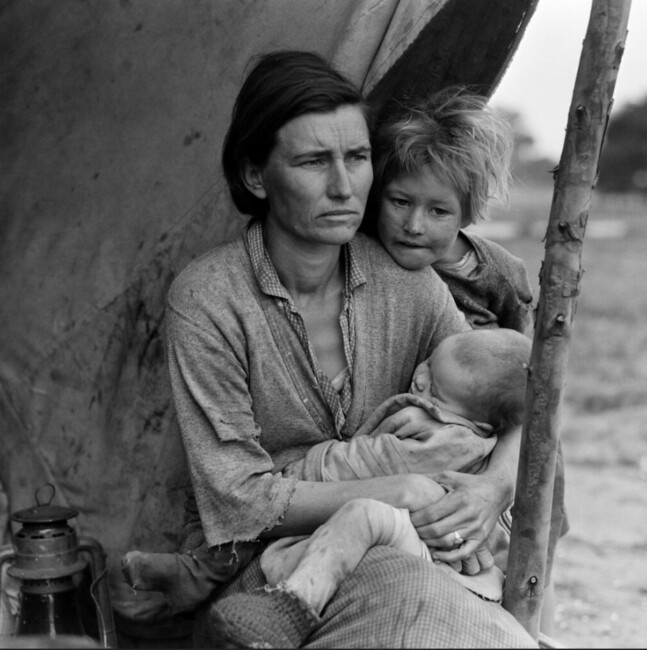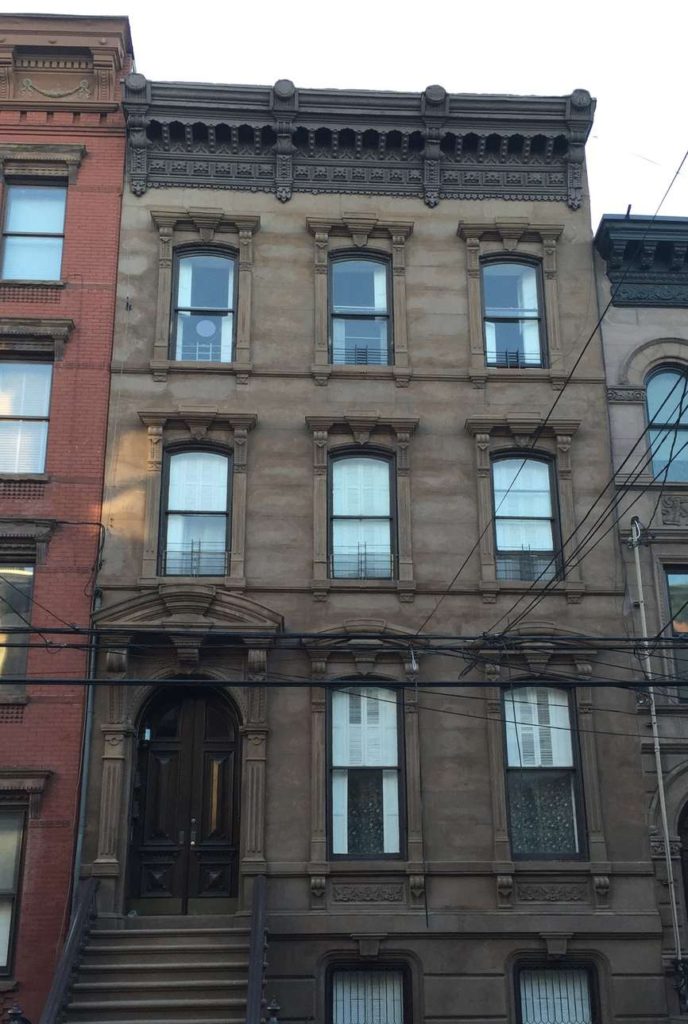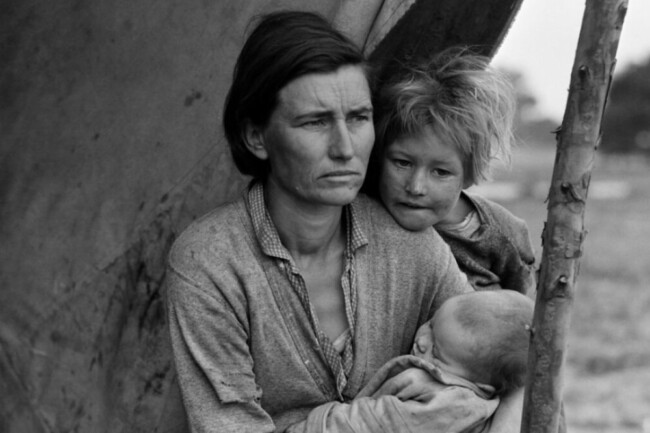Pop culturally speaking, ask a handful of people and they’ll say Hoboken is most well-known for swooning ‘Frankie Blue Eyes’ and passionate Marlon Brando as Terry Malloy, the boxer/dock worker in On the Waterfront. But before there were Hoboken Italian and Irish immigrants, there were Hoboken Germans. From 1850 – 1917, Germans grew into the largest population and employer in the city with shipbuilding and manufacturing industries like North German Lloyd, Hamburg American Line, Keuffel & Esser, Tietjen and Lang Drydock to name a few. At twenty percent, Hoboken was so German during this time that it was called ‘Little Bremen’ and a majority of the population were middle and upper class living in the uptown portion of Hoboken.
In May of 1895, Dorthea Lange was born to one of those German families at living at 1041 Bloomfield Terrace (now Bloomfield Street) built in 1892. The daughter of librarian mother Joan Lange Nutzhorn and lawyer father Henry Martin Nutzhorn, Dorthea later became one of the most famous American documentary photographers of the 20th Century. Read on to learn more about her and her inspiring story:

(Photo credit: Public Domain)
Family Expectations
At the age of seven, Dorthea contracted polio and was left with a permanent limp that shaped her attitude on life directly. And if that wasn’t traumatic enough for a child, her father abandoned his family when Dorthea was 12 and she never saw him again. While Dorthea was smart and educated, she was a noted rebel who detested school and used to play hooky to roam both city museums and the rough streets equally. Her limp from polio caused her to feel like she was invisible to others and while sad, being “unseen” became a gift in her work later as a skilled observer who was not observed herself.
In 1913 at the age of 18, Dorthea was expected to be like any other educated working woman of the time and become a teacher, secretary, librarian, or nurse but she was not interested in any of those careers. She specifically decided upon a photography career despite being a woman, not having a camera, and never having taken a photo. Divine intervention played its part one day that same year when she walked by famous photographer Arnold Genthe’s shop in Manhattan. She went in and with no experience, yet he decided to give her a job based on her grit, interest, and determination.
On Her Own
Fiercely independent, by age 23, Dorthea traveled cross-country with a friend where they got pickpocketed in San Francisco with no way (or money) to get home. Dorthea desperately needed money, so she opened a portrait studio of her own. Close to immediately, she began a successful career photographing the upper class of society in San Fran. She also joined a camera club and through this club, she met her first husband Maynard Dixon, a western wilderness painter. On March 21, 1920, they were married and began traveling together — he would paint and she would take photographs.
Spiritual Awakening
When the stock market crashed in 1929 and the country slipped into The Great Depression, life shifted for America and Dorthea had what she called a spiritual awakening. By then, no one had any money for basics in life, so there was no way anyone could afford to purchase photographs and paintings. This is when she took on street photography where she photographed the poor and indigent.
In 1933 Dorothea’s photographs were exhibited in Willard Van Dyke’s studio in Oakland California. There she met Paul Taylor, an economics professor and writer. Paul was impressed with Dorothea’s talent and they began to work together — Dorothea would take photographs and Paul would write articles. By this time Dorothea’s marriage to Maynard was deeply challenged and in October of 1935, they divorced. A couple of months later Dorothea and Paul Taylor married and continued to work together. Her most famous American photograph, ‘Migrant Mother’ was taken during this time.

^ Dorthea’s birthplace and childhood home at 1041 Bloomfield Street
The Famous Photo
Dorthea took the picture in California at a blighted pea picker farm where men, women, and children were starving to death. The photograph was published in the San Francisco news and spread immediately throughout the country. Her portrait and Paul’s writings caught the attention of Washington D.C. and as a result, twenty thousand pounds of food were sent out to the starving people on the farm. Their reports later helped start what was called the Farm Security Administration, a New Deal agency created to combat rural poverty.
READ: Hoboken #TBT: The Willow Terrace
Overnight, the woman in the photo became the iconic face of The Great Depression and there are few images as deeply ingrained in American’s consciousness. She was later discovered to be Florence Owens Thompson who for shame never wanted her identity revealed. With her children hiding behind her for protection, the ‘Migrant Mother’ gazes mournfully into the distance. At the time, the dust blown interior of the United States was full of families like hers, whom poverty had forced off their land and into a life of wandering. Drought, economic hardship, agricultural industry changes, and bank foreclosures forced tenant farmers out of the Midwest to California. They were called “Okies” and their poverty was total. Later it was revealed that just prior to the shot being taken, Ms. Thompson had sold the tires off her car for food. Ms. Thompson was finally located in a Modesta California trailer park in 1978 at the age of 75 and never received a penny for the photograph until after her death when her family, in a continuation of heartbreaking sadness, had to fundraise for her funeral.
World War II
By 1940 America’s attention shifted from The Great Depression to World War II. Dorthea and Paul stopped working for the Farm Security Administration and were hired by the War Relocation Authority. Dorthea was assigned to take photographs of the Japanese-Americans movement to the refugee camps, another dark time in American history.
From 1942 to 1957, Dorothea traveled with her son Daniel who had become a writer. They worked prolifically together on projects just like Dorothea and her husband Paul had done. In 1958 Paul and Dorothea started traveling again going to Asia, Venezuela, Ecuador, and Egypt continuing to work on political and social issues almost until her death in 1965.
Dorthea’s Final Years
In August of ‘65 Dorothea was diagnosed with esophageal cancer. During the last part of her years, she had exhibitions in Boston and Europe. She even completed her pictures for the book ‘The American Country Woman’ and worked on two films for the National Educational Television and Radio Center. Dorothea died that same year on October 11 at age 70. A few months later in January of 1966, her photographs were exhibited at the Museum of Modern Art in a show that she helped curate. In 2003, Lange was inducted into the National Women’s Hall of Fame, and in 2006 an elementary school was named in her honor in Nipomo, California near the site where she photographed ‘Migrant Mother.’ Finally, in 2008 Lange was inducted into the California Hall of Fame. All in all, we say nicht schlecht (not bad) for a little German-American girl from Hoboken, New Jersey.
See More: The Kicka$$ Hoboken Girl Martha Stevens
What’s your favorite part about Hoboken history? Share with us in the comments below!










